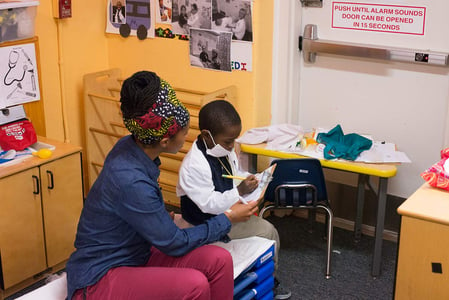
Numerous studies indicate that the CLASS is a valid measure of instructional quality. But, what exactly does that mean? Simply put, it means that the CLASS measures those aspects of teaching that lead to student achievement, typically measured with standardized assessments.
Research conducted in classrooms from preschool up to high school confirms that each domain of the CLASS is associated with academic growth. For example, Emotional Support in preschool is linked to oral language, receptive and expressive vocabularies, early reading outcomes, and math achievement. Similarly, effective Classroom Organization in preschool leads to improved academic outcomes, including language and literacy skills, early writing skills, listening comprehension, and tests of early numeracy, while Classroom Organization is linked to gains in reading for students in K-3 settings. Higher levels of Instructional Support are associated with language and literacy skills in preschoolers, and leads to improved vocabulary and letter-word knowledge in kindergarten. We want to highlight two studies in particular that demonstrate these clear links between classroom quality (as defined by CLASS) and student outcomes that have real-world implications.
The first study, conducted by Johnson, Markowitz, Hill, and Phillips (2016), looked at differences in academic achievement in two groups of children, children who attended a publicly funded preschool program and children who did not attend publicly funded preschool. In the spring of their kindergarten years, children were assessed on three subtests of the Woodcock-Johnson: Letter Identification, Spelling, and Applied Problems. Findings showed that children who attended a publicly funded preschool classroom with higher levels of Instructional Support outperformed their comparison peers. Data revealed that a one-point increase in the standard deviation of the IS score led to a 14% average increased impact on Letter Identification, a 12% average increased impact on Spelling, and a 23% average increased impact on Applied Problems. Furthermore, children in this program whose classrooms did not provide a higher level of IS did not significantly outperform those children who did not attend preschool; suggesting that this strong level of Instructional Support contributed to these gains in achievement.
Allen, Gregory, Mikami, Lun, Hamre, & Pianta (2013) examined the link between CLASS scores and academic achievement in a sample of secondary students from six school districts. They found a strong association between CLASS scores and student performance on the end-of-the-year state mandated achievement tests. Surprisingly, while all three domains of CLASS-Secondary were related to improvements in achievement, it was Emotional Support that had the strongest influence. For example, a student who came in with average scores on the previous end-of-the-year test made significant gains when the classroom teacher exhibited high levels of Emotional Support.
These are just a few among the numerous studies that demonstrate the relationship between CLASS and academic achievement. They also illustrate two important points: the quality of classroom interactions is essential for children’s learning, regardless of student age, and CLASS is an effective lens to capture and identify these effective components of learning.
Citations:
Allen, J., Gregory, A, Mikami, A., Lun, J., Hamre, B., & Pianta, R. (2013). Observations of effective teacher-student interactions in secondary school classrooms: Predicting student achievement with the Classroom Assessment Scoring System – Secondary. School Psychology Review, 42(1), 76-98.
Johnson, A.D., Markowitz, A.J., Hill, C.J., & Phillips, D.A. (2016). Variation of impacts of Tulsa pre-K on cognitive development in kindergarten: The role of Instructional Support. Developmental Psychology, 52(12), 2145-2158.

